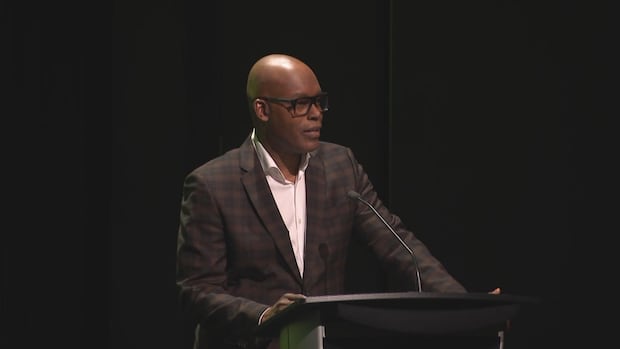Linda Mangalathu’s problems began with an issue many homeowners in Toronto are familiar with: a minor basement flood.
Now, a little more than three weeks later, she’s had to move out of her Scarborough house, her front yard is a construction zone, and neither her contractor nor the city have yet discovered the source of the water that’s leaking into her home.
Adding to her problems: the city on Wednesday deemed the structure of the house unsafe, thanks to all the excavation in the front yard.
Her bill so far stands at $30,000 and could climb past $50,000, she’s been told by her contractor — not including any additional costs to repair the house’s structure.
“Financially, emotionally, I’m stressed,” says Mangalathu, who’s lived in the Morningside-Highway 401 area house for 26 years. “I’m not able to sleep; it’s heartbreaking.”
Mangalathu’s problems began on April 29, when her son Shane noticed water coming up through the shower drain.
That inconvenience led to a $300 visit from a plumber — a visit that she assumed would end the problem.
It was just the beginning.
The plumber told her the home’s sewer lines were blocked somewhere between the house and the street, and that a contractor with expertise in uncovering buried pipes would have to be brought in to dig into her driveway. That, she was told, would be another $3,900.
In the meantime, water also began appearing in her basement through a floor drain in the furnace room.
By May 1, the entire basement was knee-deep in water, some of which was coming in through the foundation, the plumbing contractor told her later, and she was forced to move with her husband and two children, Shalia, 25, and Shane, 23, to her brother’s home in Pickering.

The contractor then brought in pumps to drain the basement and keep it relatively dry.
Also on May 1, the contractor dug through her front yard down to the storm and sewer pipes, and determined that they had collapsed under the weight of wet soil — a problem he couldn’t fix.
Mangalathu tried more than a dozen plumbing contractors, none of whom felt confident that they could tackle a job of that magnitude, she says. They recommended a heavy equipment operator be brought in to excavate the entire front yard and replace the broken pipes, she says, even though no one knew for sure whether that was the source of the flooding.
That’s when Mangalathu contacted excavator Benjamin Sarault of Henry’s Bobcat Service. By then, she knew the scope of her job was going to cost more money than she had saved.

“I don’t know how much in debt I will be,” Mangalathu said.
Sarault, who has been on the job for about two weeks, says he’s established that the home’s weeping tile system — a perforated pipe that circles a house to collect any underground water — is intact and delivering any water it catches into the storm pipe, as it should.
But that damaged storm pipe could be spilling the water right back into the soil around the house, he says. From there, the water could be making its way back through the foundation into the basement — but he acknowledges that’s just a guess.
Sarault has now created a two-and-a-half-metre deep pit in Mangalathu’s front yard to uncover the broken pipes.

But he said in an interview Tuesday he can’t fix the damaged section until the city shows up to fix its end, where the storm pipe connects to the city sewer system.
City staff told CBC Toronto in an email Thursday they are investigating the situation, and are now on-site working to repair the city sewer pipe.
So far, the city’s email says, their crews have determined the leak is not coming from the city’s water supply pipe to the house.
Structural damage
But on Wednesday, a city inspector examining the excavation delivered more bad news to Mangalathu. He told her all the construction work has damaged her house’s foundation. The inspector gave her written notice that she had to hire an engineer and present a report on the damage to the city within 24 hours, an order that’s added more stress to Mangalathu’s situation, she says.
“Where would I find an engineer?” she said. “What will that cost?”
So far, she says, she’s racked up $30,000 worth of bills. That will go up, she knows, as the final repairs to the pipes — and now, possibly, the house’s structure — are done and her home’s front yard is repaired.
Sarault estimated she’ll be facing a bill for $50,000 by the time all is said and done, not including any work ordered by the structural engineer.
As of Thursday morning, she was canvassing her contractors looking for an engineer, without success.
Closer to $70,000, homeowner predicts
Mangalathu herself pegs the figure closer to $70,000, only about $15,000 of which will be covered by her insurance company, she says.
She says she’ll also have to compensate her neighbours, who’ve seen their front yards covered with piles of asphalt, earth and pumping equipment.
Dilvir Kalsi, who’s lived next door to Mangalathu for a decade, says she feels for her.
“There’s so much sympathy in our hearts for our neighbours,” she says. “We feel so bad.”
As for the source of the water, city staff say they’re investigating but there are no hidden underground streams in the area.
‘Abandoned and desperate’
Mangalathu has contacted Mayor Olivia Chow’s office. A staff person replied telling her the problem is being investigated by Toronto Water.
“We feel abandoned and desperate,” Mangalathu told CBC Toronto. So desperate, she said earlier this week, she’s considering moving — if she can find a buyer.
“Maybe someone else will be able to fix it,” she says. “Come buy my house.”
Daughter Shalia, an elementary school teacher, says she too has been feeling the strain.
“Home is supposed to be your safe space,” she said. “That’s been taken away. So where do I look to feel safe?”





